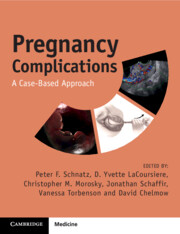Book contents
- Pregnancy Complications
- Pregnancy Complications
- Copyright page
- Contents
- Contributors
- Preface
- Note from the Editor-in-Chief
- Normal Laboratory Values (Conventional Units) []
- Section 1 Antepartum (Early Pregnancy)
- Section 2 Antepartum (Mid-trimester)
- Case 12 A 25-Year-Old with Cervical Insufficiency at 18 Weeks
- Case 13 A 25-Year-Old with an Echogenic Cardiac Focus at 19 Weeks’ Gestation
- Case 14 A 20-Year-Old with Right Lower Quadrant Pain at 15 Weeks’ Gestation
- Case 15 A 40-Year-Old with Decreased Libido at 29 Weeks
- Case 16 A 35-Year-Old with a Left Breast Mass at 35 Weeks
- Case 17 A 25-Year-Old at 14 Weeks’ Gestation with Pelvic Pain and Inability to Void
- Case 18 A 35-Year-Old with Abdominal Cramping and Pelvic Pain at 24 Weeks’ Gestation
- Case 19 Appendicitis Presenting as Nausea, Vomiting, and Abdominal Pain at 16 Weeks
- Section 3 Antepartum (Late Pregnancy)
- Section 4 Antepartum (Medical Complications)
- Section 5 Antepartum (Infectious Complications)
- Section 6 Intrapartum/Delivery
- Section 7 Postpartum
- Section 8 Fetal Complications
- Section 9 Placental Complications
- Section 10 Complications of the Cord, Amnion, and Gravid Uterus
- Section 11 Psychosocial Considerations
- Index
- References
Case 12 - A 25-Year-Old with Cervical Insufficiency at 18 Weeks
from Section 2 - Antepartum (Mid-trimester)
Published online by Cambridge University Press: 08 April 2025
- Pregnancy Complications
- Pregnancy Complications
- Copyright page
- Contents
- Contributors
- Preface
- Note from the Editor-in-Chief
- Normal Laboratory Values (Conventional Units) []
- Section 1 Antepartum (Early Pregnancy)
- Section 2 Antepartum (Mid-trimester)
- Case 12 A 25-Year-Old with Cervical Insufficiency at 18 Weeks
- Case 13 A 25-Year-Old with an Echogenic Cardiac Focus at 19 Weeks’ Gestation
- Case 14 A 20-Year-Old with Right Lower Quadrant Pain at 15 Weeks’ Gestation
- Case 15 A 40-Year-Old with Decreased Libido at 29 Weeks
- Case 16 A 35-Year-Old with a Left Breast Mass at 35 Weeks
- Case 17 A 25-Year-Old at 14 Weeks’ Gestation with Pelvic Pain and Inability to Void
- Case 18 A 35-Year-Old with Abdominal Cramping and Pelvic Pain at 24 Weeks’ Gestation
- Case 19 Appendicitis Presenting as Nausea, Vomiting, and Abdominal Pain at 16 Weeks
- Section 3 Antepartum (Late Pregnancy)
- Section 4 Antepartum (Medical Complications)
- Section 5 Antepartum (Infectious Complications)
- Section 6 Intrapartum/Delivery
- Section 7 Postpartum
- Section 8 Fetal Complications
- Section 9 Placental Complications
- Section 10 Complications of the Cord, Amnion, and Gravid Uterus
- Section 11 Psychosocial Considerations
- Index
- References
Summary
Cervical insufficiency is defined as the inability of the uterine cervix to retain a pregnancy, resulting in the subsequent delivery of the pregnancy in the absence of signs and symptoms consistent with labor, placental abruption, or both during the second trimester. It can be diagnosed based on obstetrical history, where painless cervical dilation in the second trimester led to pregnancy loss, or through physical examination findings in a current singleton pregnancy, revealing advanced painless cervical dilation. Treatment methods primarily rely on cervical cerclage placement using either transvaginal or transabdominal approaches. A cerclage may also be indicated to reduce the risk of preterm birth in a current singleton gestation with a shortened cervical length of under 25 mm, especially in the context of a history of preterm delivery before 34 weeks of gestation. The use of vaginal progesterone alone for the treatment of cervical insufficiency has not demonstrated effectiveness, although it might be beneficial in patients with singleton pregnancies and an incidentally found shortened cervical length.
- Type
- Chapter
- Information
- Pregnancy ComplicationsA Case-Based Approach, pp. 37 - 39Publisher: Cambridge University PressPrint publication year: 2025

